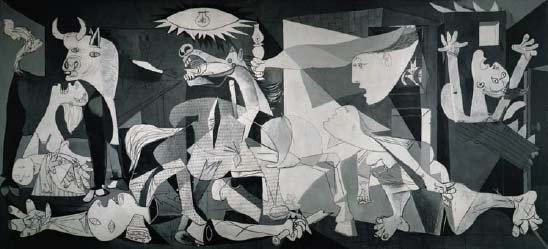From the Industrial Revolution to World War I, C. 1850–1914Early Twentieth-Century Art |
Who was Pablo Picasso? |
Pablo Picasso (1881–1973), is perhaps one of the most famous modern artists of all time. Born in Spain, he produced thousands of works of art during his lifetime, and is known for his artistic genius and avant-garde innovations. Picasso was a painter and a sculptor and experimented with collage, mixed media, and sculptural assemblages. He is credited with developing Cubism (along with fellow Cubist and fierce competitor Georges Braque), he helped to popularize non-Western art, and he experimented with symbolism, expressionism, classicism, surrealism, and more.
Like many of the great artists described by Giorgio Vasari in The Lives of the Artists, Picasso’s talent was discovered at a young age by his father, also an artist. He began formal artistic training as a young boy and was admitted to the School of Fine Arts in Barcelona at fourteen years old. During his studies at this school and others, he copied the work of the Great Masters and then later began to socialize with avantgarde circles of artists and thinkers.
Picasso’s work features a range of styles, media, and forms, and is therefore categorized into “periods,” including the early “Blue Period.” During Picasso’s Blue Period, he painted The Guitar Player (1910), a melancholy portrait of a social outcast playing the guitar with long, bony fingers. After the Blue Period was Picasso’s so-called “Rose Period” during which his work became brighter, more delicate, and more varied in color. Work from Picasso’s Rose Period includes The Family of Saltimbanques (1905), a painting that depicts a group of traveling acrobats appearing lost in a desolate landscape.
One of Picasso’s most important paintings is Guernica (1937), a monumental work inspired by atrocities committed by Spain’s far-right political party, the Falange, which was responsible for bombing the Basque city of Guernica, killing nearly two thousand people. The painting’s dimensions reach nearly 12 x 25 feet. It is a mass of complex imagery and swooping, disjointed human and animal figures in monochrome. Guernica was exhibited at the Exposition Universelle (World’s Fair) in Paris in 1937, and has since become so famous that its political impact has been upstaged by its importance as a visual masterpiece.

Guernica, painted in 1937 by Pablo Picasso, is a visual representation of the atrocities of war and is powerfully rendered through its monumental size and flailing, nearly abstract figures that are steeped in symbolism. (Art courtesy The Bridgeman Ait Library, © 2013 Estate of Pablo Picasso / Artists Rights Society [ARS], New York)
